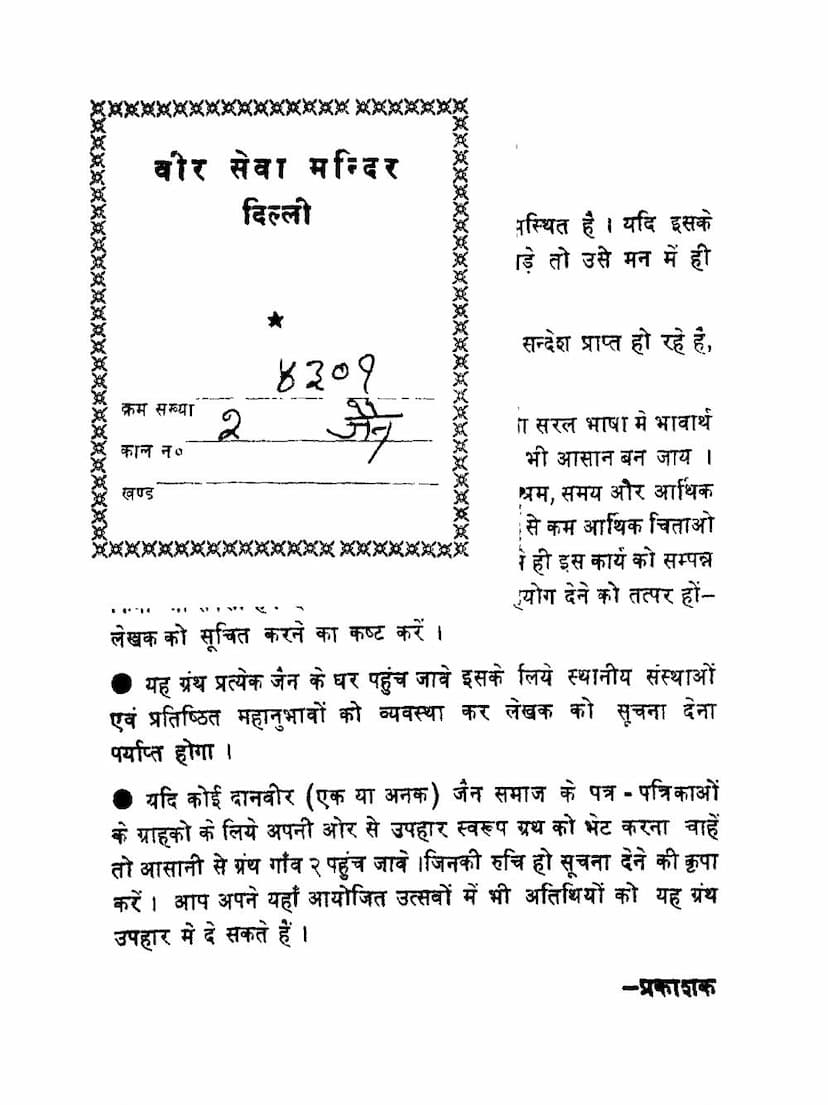Samaysar Vaibhav
Added to library: September 2, 2025

Summary
This is a comprehensive summary of "Samaysar Vaibhav" by Nathuram Dongariya Jain, based on the provided text:
Book Title: Samaysar Vaibhav Author: Nathuram Dongariya Jain (based on the original work by Shrimad Bhagvat Kundkundacharya) Publisher: Jain Dharm Prakashan Karyalaya
Overall Purpose and Nature of the Book:
"Samaysar Vaibhav" is presented as a poetic commentary (in Hindi verse) on the profound Jain scripture "Samaysar" (also known as "Samayaprabhuta") by Acharya Kundkund. The author, Nathuram Dongariya Jain, aimed to make the complex philosophical concepts of Samaysar accessible to a wider audience in a simpler language. The book emphasizes the core Jain teachings on the nature of the soul, liberation, and the path to spiritual realization.
Key Themes and Concepts Discussed:
The book delves deeply into Jain philosophy, focusing on the following:
- The Nature of the Soul (Atma): The primary focus is on understanding the true nature of the soul as pure consciousness, inherently blissful, and distinct from the physical body, karma, and other worldly substances. It highlights the soul's inherent purity and its eternal, unchanging essence.
- Nayas (Standpoints) and Syadvada: A significant portion of the book is dedicated to explaining the different philosophical standpoints (Nayas) used in Jainism, particularly the distinction between Nishchay Naya (ultimate truth, referring to the soul's pure, essential nature) and Vyavahar Naya (conventional truth, referring to the soul's manifested states and interactions in the world). The book stresses that both Nayas are essential for a complete understanding of reality and that true knowledge comes from their balanced application within the framework of Syadvada (the doctrine of manifold standpoints).
- The Path to Liberation (Moksha): The book outlines the path to liberation, which involves:
- Right Faith (Samyakdarshan): Correctly understanding the seven tattvas (realities) and having faith in the Jain path.
- Right Knowledge (Samyakgyan): Comprehending the true nature of the soul and other realities through scriptural study and reasoning.
- Right Conduct (Samyakcharitra): Practicing vows, ethical conduct, and spiritual discipline to shed karma.
- Karma and its Effects: The book explains the intricate workings of karma, its various types, and how it binds the soul to the cycle of birth and death. It emphasizes that while karma influences the soul's manifested states, it does not alter the soul's essential nature. The book distinguishes between the soul's own inherent qualities and the modifications brought about by karmic influx (Asrava) and its bondage (Bandha).
- Ignorance (Ajnana) and Delusion (Moha): The book identifies ignorance and delusion as the root causes of suffering and the soul's entanglement in the cycle of rebirth. It explains how mistaking the non-self (body, karma, external objects) for the self leads to attachment, aversion, and further karmic accumulation.
- Distinguishing Self from Non-Self: A crucial aspect is the emphasis on "Bhed Vigyan" (discrimination between the self and the non-self). The book uses numerous analogies and examples to illustrate that the soul is distinct from the body, senses, emotions, and even karmic particles, despite their apparent association.
- The Importance of Effort (Purushartha): While acknowledging the role of karma, the book also highlights the importance of individual effort (Purushartha) in breaking free from karmic bondage and achieving liberation.
- Critique of External Practices without Inner Realization: The book cautions against merely performing external rituals or adopting ascetic appearances without genuine inner realization and understanding of the soul's true nature.
Structure and Content Overview:
The book is structured as a commentary on the chapters of Samaysar, with each chapter of Samaysar being presented and explained in poetic verses. The content covers:
- Mangalacharan (Invocation): A devotional opening.
- Introduction and Author's Pledge: The author's intention to elucidate Samaysar in simple Hindi verse.
- Explanations of Core Jain Concepts: Detailed discussions on Nayas (Nishchay, Vyavahar, Upcharit), the nature of the soul, the path to liberation, the workings of karma (Asrava, Bandha, Nirjara), and the ultimate state of Moksha.
- Detailed Chapters based on Samaysar: The book seems to follow the structure of Samaysar, discussing:
- Jivajiva Adhikara: The nature of the soul and non-soul.
- Karta-Karma Adhikara: Who is the doer and what is the acted upon (karma).
- Punya-Papa Adhikara: Merit and demerit karma.
- Asrava Adhikara: Influx of karma.
- Samvara Adhikara: Cessation of karmic influx.
- Nirjara Adhikara: Shedding of karma.
- Bandha Adhikara: Bondage of karma.
- Moksha Adhikara: Liberation.
- Sarva Vishuddha Gyana Adhikara: Pure knowledge.
- Praiseworthy Aspects: The book is praised by prominent individuals for its clarity, the author's skillful poetic rendering of complex ideas, and its potential to dispel spiritual misconceptions.
- Authenticity and Tradition: The book's preface and acknowledgments emphasize its adherence to the teachings of Acharya Kundkund and the unbroken lineage of Jain tradition.
Author's Intent and Contribution:
Nathuram Dongariya Jain's contribution is to make the profound and often difficult teachings of Samaysar accessible through a poetic medium in Hindi. He aimed to clarify potential misunderstandings, particularly regarding the application of different Nayas, and to inspire spiritual inquiry and practice among Jain followers. The book is a testament to his dedication to propagating Jain spiritual knowledge.
In essence, "Samaysar Vaibhav" serves as a guide, offering a poetic and accessible interpretation of one of the most important Jain texts, encouraging readers to understand their true nature as pure souls and to embark on the path of liberation.